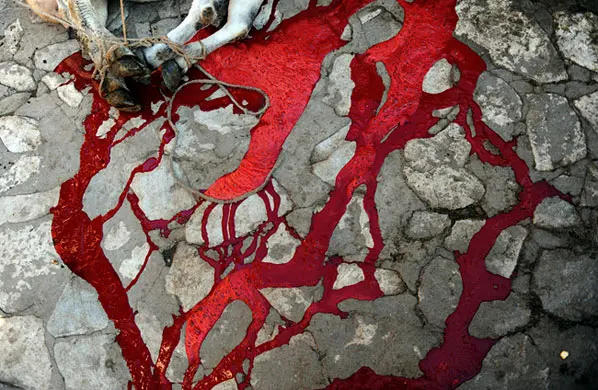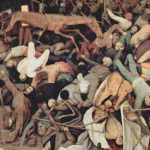
Abū Bakr was known for his meticulous adherence and avoidance of any innovation, and al-Shāṭibī’s Kitāb al-I‘tiṣām records Abū Bakr’s statement: “I am not neglecting anything that the Messenger of Allah used to do without myself doing the same. But I fear that I have neglected some things and have deviated from what he commanded". [1]
THERE ARE MANY EVIDENCES of this contradiction, but let us compare everything we mentioned earlier before moving on to the social aspect of this religious ritual. The first point is just how closely there is a correspondence between the Hebrew text and the Islamic text: the impermissibility, for instance, of sacrificing an animal that shows signs of disease, or lameness, blindness or mange; the preference for a top quality, fatted animal – for the Prophet used to sacrifice a white-horned ram; the validity of a sacrifice being exclusively from livestock: cattle, camels, sheep, goats and lambs, and – most importantly – the absolute resemblance to pagan religious ritual, for all the differences from monotheistic religions.
The essential idea was the same: there is a god who asks for sacrifices in exchange for granting his blessing to the believers and his forgiveness of their sins, and the way sacrifices brought believers closer to him and constituted a form of worship of him.
Were the monotheistic religions unaware of the prevalence of these pagan practices and the absurdity of these acts that turn humanly unacceptable and meaningless acts of slaughter into a preferred means of obtaining blessings, the forgiveness of sins and achieving closeness to God?
Of course, this is not the case, but we are dealing with human beings who were close in thought, intention and behaviour, and living under the same conditions that made the idea of sacrifice and slaughter and offerings appear real and acceptable as a human solution in the form of a pragmatic, deceptive device to deal with the dilemma of the natural world, life and the issues that man has faced throughout the ages, and attempted to resolve in ways consistent with his mental and cognitive capacity.
The essential idea was the same: a god who asks for sacrifices in exchange for granting his blessing to the believers
But why this emphasis on the ram?
The idea of sacrifice stems from the heritage and ancient beliefs that go back considerably more than four thousand years BC, where for the ancient Egyptians, the fashioners of civilization and mythology, the ram was a symbol of Amun the god of fertility. It was also a symbol of Khnum the god of clay and pottery, referring to the clay from which creation first emerged. For the ancient Indians the ram represented a symbol of Agni the god of thought and fire, and also symbolised the god Indra, the teacher of the gods and priests and the great symbol of divine monotheism. In Greece the symbolism of this animal was associated with Apollo the god of the pastoralists.
The ram also had a place in mankind’s religions even before the Abrahamic story, so it is not strange that it represented a stand-in for the slaughter of Ishmael or Isaac, or represented Christ as the Son of God, but in the Islamic religion we find deep in the folds of the heritage a vision of the ram as a symbol of death in the afterlife. We can see this when Muḥammad addresses the inhabitants of Heaven and Hell:
“When the people of Paradise enter Paradise and the people of Hell enter Hell, death will come as if it were a pied ram and it will stand between Paradise and Hell and it will be said, ‘O people of Paradise, do you recognise this?’ And they will crane their necks to look and say, ‘Yes. This is death’. Then it will be said, ‘O people of Hellfire, do you recognise this?’ And they will crane their necks to look and say ‘Yes. This is death’. Then it will be laid down and slaughtered, and it will be said, ‘O people of Paradise! For you, there is an eternity without death!’ and ‘O people of Hellfire! For you, there is an eternity without death.'”
Leaving aside the contradictions we mentioned earlier about the permissibility of following this sunna or not, is it permissible now, while we are living in difficult economic conditions, to at least abandon this sunna, in conformity to the hadith of the Prophet:
Whoever can afford to do so, but does not offer a sacrifice, let him not come near our prayer place[2]
which places the condition of material means to make the sacrifice, but for those who do not have those means it will not be held against them? You will come across many who cite this hadith in agreement and deplore the increasing costs burdens involved in funding this sacrifice, but this is mere talk and does not go beyond a private exchange of views on the matter.

Suggested Reading
When will Muhammad’s nation free itself from its sacralised myths?
Reality tells a different story: many go all out to fund the sacrifice, even if it means resorting to borrowing from financial institutions or from friends and family, with some resorting to selling off household items to purchase the sacrificial ram, in a blatant manifestation of social pretense. More seriously, families compete over who will buy the largest sheep for the eid, and woe to those whose financial resources are not up to it – his neighbours and relatives will not hesitate to turn it into a theme for gossip and public ridicule.
All of which raises many questions about our religious culture and its tendency towards religious formality instead of actual religion, and who it is that strains to maintain such a practices. There is, of course, that legal dictum that runs:
Cui bono? If you want to know who is the perpetrator, look for who benefits from the crime.
The biggest beneficiaries of this crime of burdening families with an obligation that God did not authoritatively reveal are the major traders and capitalists, who seek out opportunities to invest in everything – including acts of worship, religious rituals and even social customs, and then turn them into a means for increasing profits, even if this is done illegally, uncontrollably, and under a religious cover.
The result is religion objectified and stripped of its spiritual aspects.
[1] Abū Isḥāq al-Shāṭibī, Kitāb al-I‘tiṣām, Part VIII, p.55.
[2] Sunan Ibn Mājah 3123.
Sources used in this essay:
Will Durant: The Story of Civilisation.
‘Abd al-Ḥamīd Zāyid, الشرق الخالد: مقدمة في تاريخ وحضارة الشرق الأدنى من أقدم العصور حتى عام 323 ق.م
Anīs Farīḥa, دراسات في التاريخ .
Jawād ‘Alī, المفصل في تاريخ العرب قبل الإسلام.
Maḥmūd Al-Ḥūt,في طريق الميثولوجيا عند العرب.
جان بوتيرو, الديانة عند البابليين.
Sāmī Labīb, الله والذبائح والأضاحى-الأديان بشرية الهوى والهوية , الحوار المتمدن, No. 3886.
Ibn Kathīr, Al-Tafsīr, Part IV.
Abū Isḥāq al-Shāṭibī, كتاب الاعتصام.
Ibn Ḥajar al-‘Asqalānī, سبل الإسلام.
Main image: Blood drains away from a cow slaughtered for the celebrations in the Rhodope Mountains, Bulgaria

